Mark Tetto Collection

Joseon Era Portait
Ink and color on silk
Early 1900s
Living in Korea - and in particular living in a Korean traditional house (hanok) - naturally led to an interest in collecting Korean art. I curate and maintain a collection of Korean traditional and modern art. This collection spans the centuries, from an ancient Gaya-era earthenware jar (ca. 5th century) to works by contemporary Korean artists. Research and archiving - particularly of the older traditional works of art, furniture and craft - is important to contribute to a deeper knowledge of the field, and also to broaden the public understanding and appreciation of Korean heritage.
Korean Traditional Art & Craft
Ginkgo wood
19th century
This government official’s small dining table would have been used to carry food for meals served in the government office, or for nearby outdoor dining. The table would have been carried over the head, and was therefore thoughtfully designed around the human body.
Nickel
19th century
This engraved brazier would have been used by a woman of the noble class during the Joseon era. A noble woman of the era would travel by palanquin, and this portable brazier would be filled with hot coals and used to keep her warm during her travel.
Ink and color on silk
Early 1900s
The figure in this Joseon era portrait is wears the intricate green robe (단령, 團領) and accompanying hat (오사모, 烏紗帽) of an important official. His hands are lightly folded as he looks straight ahead, as if gazing directly at the viewer.
Crude iron
19th century
A “deumeu” (Korean, 드므) is a large, widely shaped iron vessel typically found in a Korean royal palace or temple, where it would be placed around the four sides of an important building and used to store water.
Ginkgo wood
19th century
This is a small medicine box used by physicians when visiting the king, carrying a few simple medicinal herbs and acupuncture tools. Both the front and rear faces of the medicine cabinet are carved with motifs of longevity.
Earthenware
6th century
This earthenware jar has a wide mouth and round ears with holes attached at the shoulders, and features a generally round body in a bluish-gray color. It has a round bottom, so it was likely used on a high stand.
Pine wood, bamboo
19th century
This Joseon-era seal box was made with pine wood and overlayed with a thin layer of interwoven black bamboo, creating a checkered surface that subtly reflects light, and revealing a simple and understated elegance.
Korean Modern & Contemporary Art
Ink and gouache on Korean paper
20th Century
Kwon YoungWoo’s career was marked by a personal quest to bring new forms of abstraction into Korean painting. An early pioneer of the dansaekhwa movement, his works on ripped or punctured paper explored its diverse interactions with ink, and the natural effect of the materials themselves.
Archival pigment print
2014
This black and white print is a work from Korean photographer Koo Bohnchang’s renowned “Vessels” series, in which the artist has captured some of Korea’s rare and precious white porcelain treasures.








